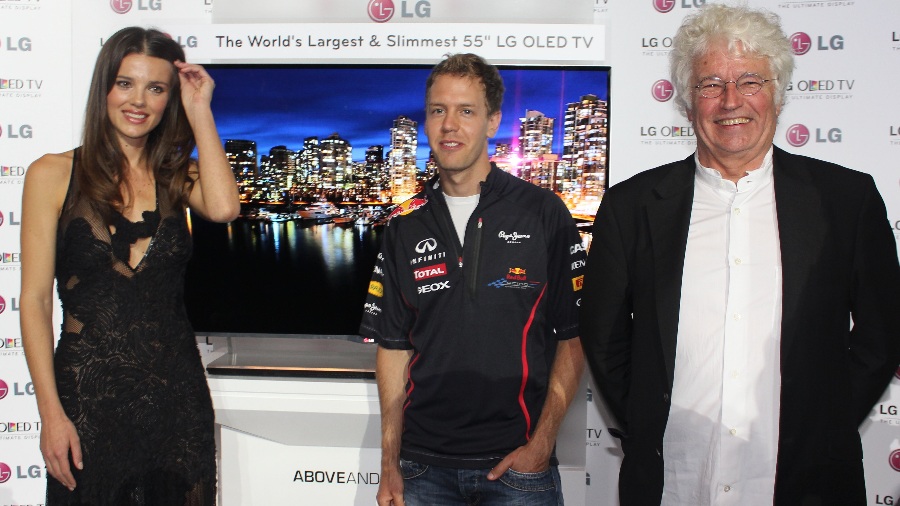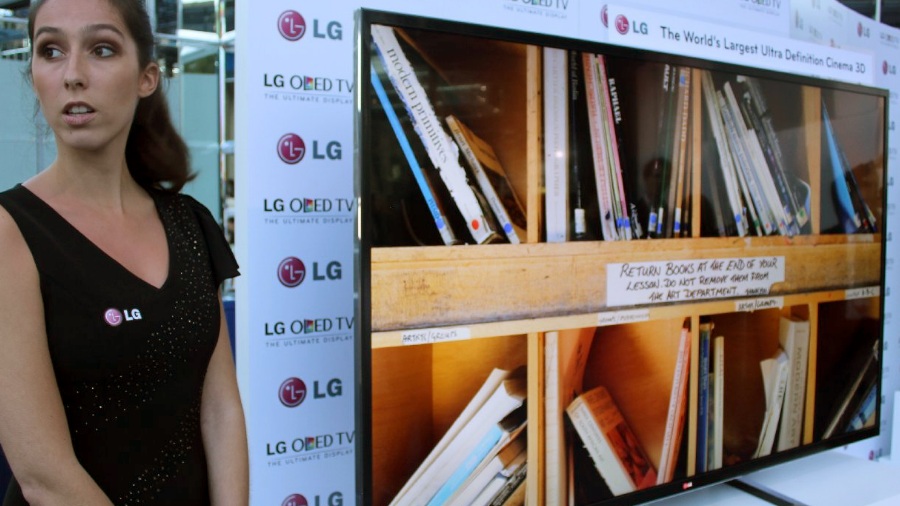
A short walk from the most glamorous circuit on the F1 calendar, LG finally took the wraps off its debut OLED TV, the 55EM960V.
Shown in prototype form at CES 2012 back in January, the revolutionary screen will be available for pre-order from July, with models shipping in the autumn. It will sell for 9,000 Euros.
To help with the Monaco unveiling, LG called upon BBC GP pundit David Coulthard and two-time F1 world champion Sebastian Vettel, as well as supermodel Gemma Sanderson and movie director Jean-Jacques Annaud. Well, if you're the Global Technology Partner for Formula One you're entitled to call in a few favours every now and then.
Few would argue that the much-hyped screen looked beautiful at the launch. Impossibly thin at 4mm and weighing a mere 10kg thanks to carbon-fiber reinforced plastic bodywork, it's cutting edge in every sense. Couple that to astounding contrast, vibrant colour reproduction and a response time said to be 100x faster than LED and you have a very special screen indeed.
Vettel described it as "amazing" and "really impressive," adding quite accurately that the high motion resolution would be perfect for sports such as F1.
Jean-Jacques Annaud was similarly impressed, saying he believed the screen's wide viewing angle could change the way people perceive 3D. As a film maker he was also hugely impressed with the clarity of OLED's imagery.
Not mass market
But with a stratospheric price tag, OLED is clearly not a mainstream proposition. Steve Gater, LG's consumer marketing director, agrees. "A mass market for OLED is years off," he says, adding it's not his intention to sell "loads" of OLED TVs.
Get daily insight, inspiration and deals in your inbox
Sign up for breaking news, reviews, opinion, top tech deals, and more.
"We don't think this will happen until the technology gets to a price that's just 1.5x that of an LED screen. What we're doing with this event is saying that OLED is now a core technology for us, that it represents a tangible picture quality improvement for consumers."
In truth, OLED represents a massive power-play by LG Display, the autonomous panel making division behind the brand. Buoyed by the successful gamble that was Passive FPR, it's now ramping up the pressure with next generation displays. Joining the OLED screen in the autumn will be an 84-inch 4K (aka Quad HD) 3D panel, which will retail for the same pocket-numbing price.
Gater is painfully aware of just how treacherous the TV business has become. After all, his brand is just one that has spent the past few years chasing market share, in the process driving the price of high-tech flatscreens down to historic lows.

In the short term, this has been great for buyers – but it's resulted in the biggest names in the business hemorrhaging cash, to the point now where talk of survival and not dominance emanates from boardrooms.
While LG won't be drawn on OLED production line yields (which are probably still poor), it was clear at CES that the company was leading this latest technological charge, forcing rival Samsung to undertake PR damage limitation. Sony could have mounted a challenge, had it not bagged off OLED after introducing the first consumer set, the 11-inch XEL-1, back in 2008.
Says Gater: "We've been working really hard to get ourselves into a position where we still have a TV business in five to ten years time. Thankfully, there will always be people prepared to buy the latest technology. There will always be early adopters."
The white sub-pixel advantage
LG's product and consumer marketing manager George Mead concedes that while LG may be first with OLED, other brands will inevitably follow. "We know other companies are going to produce OLED TVs, but we think we have the edge for a number of reasons. Our 4 Colour Pixel Technology, we think, is the best panel solution."
In a move analogous to its break from the Active Shutter 3D camp, the proprietary OLED panel LG employs features an additional white sub-pixel, which takes the pressure off the blue pixel which historically always fails early; this ensures a long life for the panel "We think we have the best, most scalable panel technology," he says.
Mead notes the challenge now is to put the screen in front of as many people as possible. "It has to be seen to be believed," he says. While the TV offers full net connectivity, a dual core processor and a remote control with voice recognition, "it's the panel which is the biggest innovation of them all.
The contrast level is absolutely incredible. We truly believe this is the future of home entertainment."
Steve has been writing about AV and home cinema since the dawn of time, or more accurately, since the glory days of VHS and Betamax. He has strong opinions on the latest TV technology, Hi-Fi and Blu-ray/media players, and likes nothing better than to crank up his ludicrously powerful home theatre system to binge-watch TV shows.
